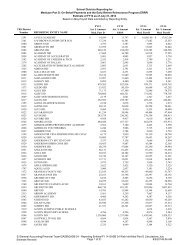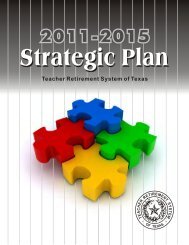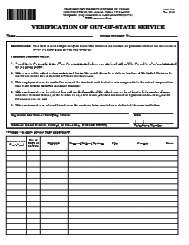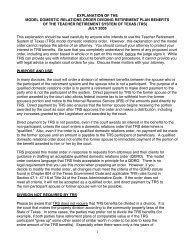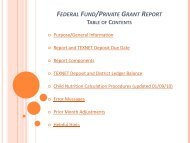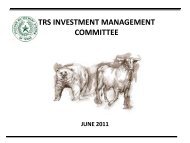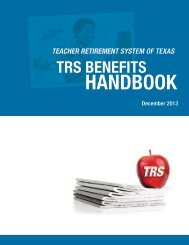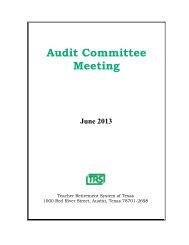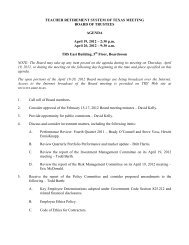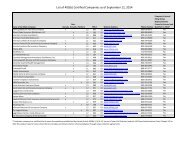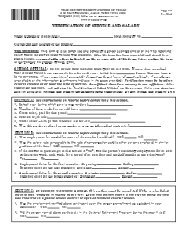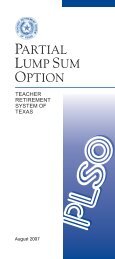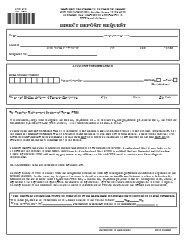TRS 2011 Comprehensive Annual Financial Report
TRS 2011 Comprehensive Annual Financial Report
TRS 2011 Comprehensive Annual Financial Report
You also want an ePaper? Increase the reach of your titles
YUMPU automatically turns print PDFs into web optimized ePapers that Google loves.
TEACHER RETIREMENT SYSTEM OF TEXAS COMPREHENSIVE ANNUAL FINANCIAL REPORT <strong>2011</strong><br />
Notes to the <strong>Financial</strong> Statements<br />
B. CASH ON HAND AND CASH EQUIVALENTS<br />
At August 31, <strong>2011</strong>, the system had $2,563,416 in cash on hand. This total is related to checks for purchases of special service<br />
that were being held pending approval of rollover transfer forms.<br />
Investments with an original maturity of three months or less and that are used for cash management rather than investing activities<br />
are considered cash equivalents. Highly liquid investments invested as part of a short-term investment fund are not considered cash<br />
equivalents.<br />
C. CUSTODY OF INVESTMENTS<br />
The system has contracted with State Street Bank and Trust Company to serve as custodian for the system’s investments.<br />
D. INVESTMENT LEGAL PROVISIONS AND OTHER CONSTRAINTS<br />
Under the Texas Property Code, Section 117.003, a trustee of the board owes a duty to the beneficiaries of the trust to comply<br />
with the prudent investor rule. In making investments, the board shall exercise the judgment and care under the circumstances then<br />
prevailing that persons of ordinary prudence, discretion, and intelligence exercise in the management of their own affairs, not in regard to<br />
speculation, but in regard to the permanent disposition of their funds, considering the probable income therefrom as well as the probable<br />
safety of their capital. Texas Government Code, Section 825.301(a), Texas Property Code, Section 117.004, and the Texas Constitution,<br />
Article XVI, Section 67(a)(3) apply in determining whether a trustee has exercised prudence with respect to an investment decision.<br />
Determination shall be made taking into consideration the investment of all the assets of the trust, or the assets of the collective investment<br />
vehicle, over which the trustee had management and control.<br />
Trustees follow the guidelines provided by the <strong>TRS</strong> Investment Policy Statement in establishing specific asset allocations, benchmarks,<br />
eligible investments and quantitative criteria with the assistance of their investment counsel and investment advisors. Trustees utilize<br />
asset allocations and portfolio standards they believe are prudent and appropriate for the long-term objectives of the fund. Categories of<br />
permissible investments include equities, debt securities, cash equivalents, alternative investments including private equity, real assets,<br />
absolute return, hedge funds, other absolute return investments, derivative instruments authorized by law, mutual funds, closed-end<br />
funds, exchange-traded funds, and commingled funds. Investment categories are based on the risk profiles exhibited by those investments.<br />
The objectives of the Private Equity and Real Asset investments is to provide a long-term rate of return in excess of the return of<br />
the Investment Policy benchmark for each authorized strategy, provide diversification to the Total Fund, and provide for enhanced returns<br />
and diversification within the portfolio by allocating assets among the various strategies. Private equity funds build portfolios of private<br />
investments in the equity or equity-rights securities of privately-owned operating companies. Real assets focus on private or public real<br />
estate equity, private or public real estate debt, infrastructure, timber, agricultural real estate, oil and gas, real asset mezzanine debt or<br />
equity, mortgage-related investments, entity-level investments, REITS, MLPs, non-fixed assets and other opportunistic investments in<br />
real assets. Funding of committed capital in either the Private Equity or the Real Asset Portfolio will occur over an extended time period<br />
and may take several years before the total allocation to each asset class is fully invested. Because an individual investment may begin<br />
to return capital to the investor prior to the full funding of the investor’s commitment, the outstanding invested capital of a Private Equity<br />
or Real Asset investment might at times be substantially less than the total commitment. Hedge funds are private commingled investment<br />
vehicles with the general characteristics as set forth in Texas Government Code, Section 825.3012. Hedge funds include private<br />
investment fund of funds or a commingled vehicle that itself invests in hedge funds. <strong>TRS</strong> investment policy establishes criteria to analyze<br />
and determine whether a private investment fund should be classified as a hedge fund. During fiscal year <strong>2011</strong>, the permissible hedge<br />
fund allocation was increased from a maximum of 5% to a maximum of 10% of the market value of the total fund on the date of each<br />
hedge fund investment as a result of a change in the Government Code. Other Absolute Return investments include credit sensitive<br />
investments as well as other limited partnerships that are not hedge funds, private equity, or real assets. A commingled fund is a fund<br />
which is (i) exempt under the provisions of Section 501(a) of the Internal Revenue Code of 1986, (ii) is not required to be registered as an<br />
investment company under Section 3(c)(1), 3(c)(7) or other provisions of the Investment Company Act of 1940, or (iii) is an investment<br />
company registered under the Investment Company Act of 1940, as amended, provided that investment and reinvestment of assets<br />
complies with the investment guidelines in all respects.<br />
FINANCIAL SECTION<br />
45



